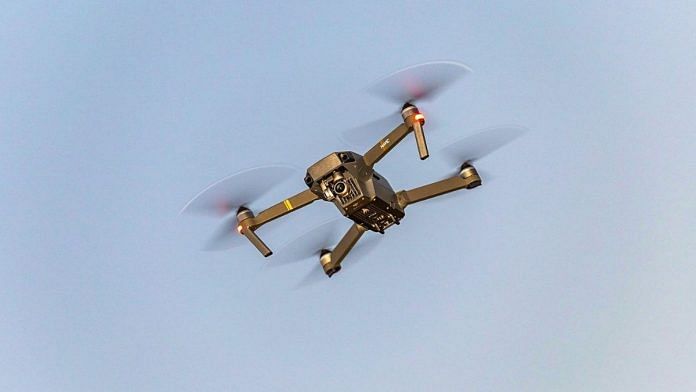New Delhi: The Ministry of Civil Aviation released a draft policy Tuesday to develop an air traffic management system for civilian drones or Unmanned Aircraft Systems (UAS).
The draft policy, called UAS Traffic Management (UTM) Ecosystem, mainly applies to drones flying 1,000 feet above ground level in uncontrolled airspaces.
It is expected to coordinate drone flight paths, manage traffic and provide weather and terrain data as an “extension of the current Air Traffic Management (ATM) Services”.
“Drones will soon need to fly alongside manned aircrafts and high levels of aviation safety should be maintained in such scenarios,” Joint Secretary of the Ministry of Civil Aviation Amber Dubey told ThePrint.
In June, the government had issued the Draft Unmanned Aircraft System Rules, 2020, which if passed, will replace the existing Civil Aviation Requirements (CAR) enacted in 2018.
Unlike CAR, the Draft UAS Rules are more exhaustive and make a clear distinction between drone regulations and other regulations that apply to conventional manned aviation.
Also read: Indian drone non-profit ties up with Amazon cloud services, eyes wider adoption of UAVs
What are drones and who can fly them
A drone is an aerial device that can navigate without a human on board or beyond line of sight. In India, drones are used for entertainment and recreational purposes, wedding photography and research but cannot be flown in ‘No Fly Zones’ such as areas near airports, international borders, State Secretariat Complex in State Capitals, strategic locations, etc.
There are three kinds of drones — Remotely Piloted Aircraft System (RPAs) piloted from a remote pilot station, Model Remotely Piloted Aircraft Systems used for educational or experimental purposes only within visual line of sight and Autonomous Unmanned Aircraft System that does not require pilot intervention.
Based on weight, ‘nano’ drones are less than or equal to 250gm, ‘micro’ drones are between 250gm-2kg, ‘small’ drones are between 2-25kg, ‘medium’ drones are between 25-150kg and ‘large’ drones are greater than 150kg.
Nano drones are usually the size of a human hand and are flown indoors.
According to the Draft UAS Rules, all drones, except those in the nano category, will have to be registered with the government. They will be issued a Unique Identification Number (UIN) and will also be required to obtain other permits and approvals from DigitalSky — an online management platform for drones set up by the government.
Over 22,000 drones and 18 models have been provisionally registered with the Government of India.
Also read: High-tech drones could have neutralised Chinese intrusions at LAC but India didn’t have them
What does drone air traffic management system look like
According to the draft policy, the UTM Ecosystem will be a software-based interface between drones, remote pilots, regulatory systems and Air Traffic Control systems to share flight information and real-time situational awareness.
The system will provide services to ease drone travel, similar to Air Traffic Control services, by preventing collision and maintaining an orderly flow of air traffic among other things.
Lalit Gupta, chief advisor at Aviation Technology Forum of India (ATFI), a private organisation, called the document “forward thinking”, which allows greater flexibility for the smallest class of drones, nano.
The online DigitalSky platform will be a core part of the UTM Ecosystem and the primary authority for drone flight approvals.
However, Gupta told ThePrint the policy fails to mention when DigitalSky will officially come into effect.
According to an industry expert, it may take at least a year for it to do so.
In the interim, the government has relied on giving exemption orders. For instance, it allowed Hyderabad-based International Crops Research Institute to use drones for agricultural research activities last month.
Also read: Why drones have raised the odds and risks of small wars



